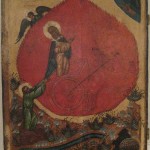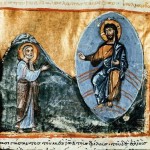 1 Kings 19:1-4, 8-15a and/or Isaiah 65:1-9
1 Kings 19:1-4, 8-15a and/or Isaiah 65:1-9
What It’s About: Both of these passages are in some way about God’s call and human response. The 1 Kings reading relates the threat to Elijah’s life on the part of Jezebel, and his journey to a cave at Horeb, where he waited for God’s presence. Along the way there were several call-and-response moments, in which God made a demand and Elijah responded. And the Isaiah reading, from the penultimate chapter of the book, is about God’s ongoing frustration and anger with the people, who are still not being faithful to the life to which they have been called. In both cases, at issue is the human response to divine commands.
What It’s Really About: It’s interesting to note that in both cases, God’s commands involve the theme of foreignness somehow. In the case of 1 Kings, Elijah’s safety is threatened by the foreign queen Jezebel, who stands in for all of the wrong things that can come with foreign influence. In the case of Isaiah, much of the frustration that God expresses can be traced to residual influences from non-Israelite religion (or, at least, religion that the writer considers unorthodox). In both passages, the dangers of external influence are clear, and they are inimical to both the people and the worship of God.
What It’s Not About: It’s not about the wind, earthquake, or fire. In this famous part of 1 Kings, Elijah is told to wait for the presence of the Lord to pass by, and a series of impressive natural phenomena follow on. God, we are told, was not in the wind, the earthquake, or the fire. It was only later, in the sound of sheer silence, that Elijah heard a still small voice that he attributed to God. The question of theophany–how God appears to humans–is interesting in the Hebrew Bible, and this passage illustrates some of the ways how. Elsewhere in the Hebrew Bible, God does appear in dramatic ways–in a burning bush, in a pillar of fire, etc–but here God resides in a subtler presence. Is this a rebuke to other understandings of God’s presence? Or is it simply a different expression of how God appears? Coming on the heels of persecution by Jezebel, it’s tempting to think that this is an argument against showy and dramatic expressions of religion, and for a more quiet, contemplative religious practice.
Maybe You Should Think About: Jezebel is one of the great villains of the Hebrew Bible. But what’s her motivation? Why is she doing the things she does in the narrative? Her villainy can seem a little one-dimensional at times, like she’s evil for the sake of being evil. What might have been her reasons for her actions?
What It’s About: This is Paul talking about the Jewish law. The context is his letter to the Galatians, a group of gentile converts in Asia Minor that he had evangelized some years earlier. After Paul left the community, another group of Christian evangelists came through, and they preached a somewhat different gospel–that gentiles needed to follow Jewish law to be followers of Jesus. This infuriated Paul (see Galatians 1), and this passage is his attempt to explain to his gentile audience why they did not need to follow the Jewish law. To do so would be to ignore and reject the person of Jesus, since Jesus’ purpose was to make the law irrelevant for the gentiles. (I am one of those adherents of the “new perspective on Paul” that believes that Paul remained Jewish, and thought the law was perfectly fine for Jews–just not for gentiles). For Paul, Jesus provides access to God’s family for gentiles in the same way that the law does for Jews, but everybody should stay in their lane–gentiles should not try to be Jews.
What It’s Really About: This passage is most famous for verse 28: “There is no longer Jew or Greek, there is no longer slave or free, there is no longer male and female; for all of you are one in Christ Jesus.” A similar verse can be found in Colossians 3:11, and most scholars think that this is a pre-Pauline formula, possibly a baptismal creed, that was known in early Christian communities. If that’s true, then it adds a lot of depth to the passage. Paul, then, would be quoting a phrase that everyone would have known, and that everyone would have heard as they were initiated into a new community. And that phrase would have been about the erasure of boundary lines between people. It’s pretty intriguing to think about this as a baptismal creed–the kind of thing that would have been said or heard at baptism. If that’s what this is, then this sentiment–the erasure of difference–would have been a summation of early Christian understanding of early Christianity. This, in that case, something close to pure kerygma.
What It’s Not About: Given the context (a Jewish Jesus-believer’s letter to gentile Jesus-believers about the need to keep Jewish law), this cannot be read as a rejection of Jewish law generally. This–and I would argue all other similar passages in the Pauline letters–is a rejection of the Jewish law for gentiles. It’s an argument for Jesus, not against the law; for Jews, the law is still God’s system of salvation.
Maybe You Should Think About: This verse (and Colossians 3:11) are expressions of the major kinds of difference that Paul knew. Jew/Greek, male/female, slave/free–those are the main ways to be different. But we know other modes of difference. In the wake of a tragedy like the terror attack/hate crime in Orlando, what would a meditation on our differences, and their possible erasure, do for us, and for our understanding of Christianity’s cure?
What It’s About: This is the story of the Gerasene demoniac, one of the most iconic stories in the synoptic tradition. Interestingly, this story exists in substantially different form across Mark, Matthew, and Luke, suggesting that Matthew and Luke were each dissatisfied with Mark’s version, and sought to change it. The details are different across the different accounts–how many demoniacs are there, what the demons’ name is, where the story takes place, and so forth. But the story is substantially the same in its progression: Jesus encounters the demoniac(s), Jesus speaks with the demon, who recognizes Jesus; Jesus tells the spirit to come out, the spirit(s) goes into a herd of pigs, and is drowned. It’s a dramatic story with memorable turns.
What It’s Really About: The earliest version of the story is in Mark, and in Mark there is a running theme–the disciples don’t recognize who Jesus is. They are constantly bumbling and making mistakes about his identity. But the demons understand who Jesus is. This story, in its setting in Mark, probably served to highlight this disparity; the demons’ understanding of Jesus’ identity would have been in stark contrast to Jesus’ own disciples’ understanding. It’s a clever literary device, in which confirmation of Jesus’ true self comes not from his allies, but from his enemies, who immediately recognize who he is.
What It’s Not About: The New Testament doesn’t know modern language for mental illness. One of the challenges of preaching a passage like this is that we recognize the behavior of the Gerasene demoniac as symptomatic of mental illness, such as schizophrenia, while ancient writers and readers understood the behavior as demonic possession. These are obviously two very different understandings of the same behavior, demanding two very different approaches. When preaching this text, you’ll need to be attentive to this problem; it will be important to be sensitive to modern understandings of mental illness, and the certainty that people in your congregation have experience with it. It’s a challenging move–to preach about demon possession without presuming demon possession–but it’s essential to preaching it well.
Maybe You Should Think About: What are the implications of thinking about a story like this in context of modern conceptions of mental illness? How does that–how must that–affect our interpretation?












